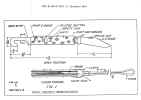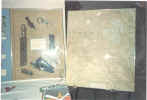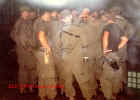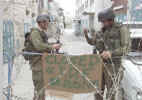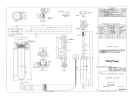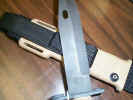Some time within the last 30 days a genuine ivory grip USMC mameluke sword
named to David Kipness was stolen from a locked showcase at Kaiser Bill's
Military Shop in Pomona.
The exact details of the theft are currently unknown however a report has been
made to the Pomona Police Department. Due to the value of the sword the crime
would be considered felony grand theft.
Anyone with any information regarding this theft should contact Lt. Colonel
David George (Ret.) at Kaiser Bill's or the Pomona Police.
Updated 12/29/01
The Rallying Cry
As I sat and watched the Pearl Harbor 60th
Anniversary ceremony I heard the latest Rally cry of "Remember September 11th."
This is now heralded as the War Against Terrorismís anthem, much like
"Remember the Alamo" was to the Mexican American War and
"Remember Pearl Harbor" was to World War Two. As it too will be a date
etched into our memory I think a much better statement would be "Letís
Roll." That statement being the last recorded words from the cell phone on
the ill fated airliner that crashed in the fields of Pennsylvania. As the
passengers rushed the cockpit of the terrorist held plane the shout of "Are
you guys ready? O.K. then... Letís Roll" are also etched into my memory
and will continue to be the words that inspire me the most.
More Quotes...
This one relayed to us via our good friend Joe Blandford,
"It is God's place to forgive Osama bin Laden, It is the
Marines job to arrange the face to face meeting!"
Paul Harvey, December 2001
Along that line while most Americanís decry this War Against
Terrorism is not a religious war I have tried to dig into it in my limited
background with various religions. If another person tries to tell me the war is
not about Islam I will attempt to strangle that person with my bare hands. If is
isnít about Islam just what in the hell is it about??
Here are a few quotes from the King James Version of the
Bible.
"He that hath no sword, let him sell his garment and buy
one." Luke 22:36
"Think not that I am come to send peace: I came not to
send peace but a sword"
Matthew 10:34
"Thus says the Lord, the God of Israel, ĎPut every man
his sword by his side, and go in and out from gate to gate throughout the camp,
and slay every man his brother, and every man his companion, and every man his
neighbor.í"
Exodus 32:27
I could not find any from the Koran which have an edged weapon
in the text. (If you know of any please forward them to me.) I did find the one
most often cited as the "reason" behind the terrorist attacks.
"Let those who fight in the cause of God who barter the
life of this world for that which is to come; for whoever fights on Godís
path, whether he is killed or triumphs, He will give him a handsome
reward."
Nothing about the reputed 72 virgins there but I imagine that
is the "handsome reward??"
Randall Model 15 White Tenite for sale
It isn't often one of these rare knives comes on the market.
They don't get much rarer then this one. Our good friend Doug Smith has one
for sale. You can contact him at dsmith559@attbi.com
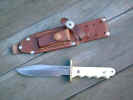
This is not the knife but it is one just like this.
The Marines Have Landed
In a recent photograph of US Marines landing in Afghanistan we see the newest
high tech weaponry along with the old tried and true 1219C2 Fighting / Utility
Knife. As with most pictures of knives in combat situations they are not usually
in focus or in good lighting. This photo is just like those others but we
can clearly see the shape of the handle and the leather scabbard on the Sgt.ís
belt. As a bonus we can also see a Gerber Multi-tool attached to the
war-fighting gear (LBE) shoulder strap. The old meets the new in the ancient
land of dust and rubble. Itís great to see the old 1219C2 soldiering on into
the 21st century. We hope it accounts for a few terrís in a hurry
to meet Allah in their own convoluted way. Now that would be a fitting tribute
to the old warhorse.
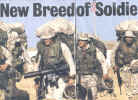
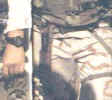
Real Shark Knives
During a recent after dinner conversation with my Father-in-law, who is a WW
II Navy veteran, the subject of Theatre knives came up. He noticed a book laying
on the table next to my favorite reading chair and picked it up. The book was
Theater Made Military Knives of World War Two by Bill & Debbie Wright. After
looking at a few pages he told me of how he and some friends had made several of
these knives with plastic handles in the ships machine shop. The conversation
floored me. We have known each other for 25 plus years and he never told me
about making knives, but to be honest I never asked. Anyway he told me of his
favorite grip material, sharkskin. It seems they would trade for sharkskin any
time possible to make handle covers for screwdrivers and pliers, tools of the
electricians trade. So if it worked for tools why not knives. They made a few
handle covers and the crew liked them. From that point on they would use
sharkskin covers to make a better and surer grip on the knives they made. I have
never heard of a theatre knife with a sharkskin handle but am now on the lookout
for one. If you happen to run across one I sure would be glad to hear from you.
M1917 Winchester Bayonet dated 1918??
I recently purchased a Model of 1917, Winchester made bayonet
in very good to excellent condition. Nothing strange there, not easy to find
but not really hard either. I over paid for it because it was dated 1918 on
the blade. Thinking I had found the only one ever to be found I agreed to pay
the extra few dollars. You see, the seller did not know what the treasure he was
holding on to was but wanted top dollar for a Winchester in "mint"
condition. So I went for $250.00 on it, you see, I knew what it was. Was that
unethical I asked myself? No not really I paid the sellers price, yes I tried
to beat him down but that is part of the game. When I got the bayonet home I
examined it closely and started to photograph it and scan some images. That is
when I noticed it. The circle W was a little crooked. Upon closed examination
the words Remington inside the circle were removed and the W engraved in it's
place. My $250.00 priceless treasure was a fake, a fraud, a fantasy, a
worthless piece of junk, or was it? In my hurry to pull one over on the
"ignorant" seller I did not do my
homework, I wanted it, and I wanted it in a hurry so he wouldn't figure out
this tragic mistake. I made the cardinal sin of letting my better judgment go
by the wayside in the rush to get away from the "scene of the crime"
so to speak. My saving grace was I returned it for a full
refund as it was discovered the same day I received it. If I had put it off
for awhile or not bothered to look closely under magnification my greed would
have gotten the better of me. Whether the seller knew or not I do not know nor
do I care at this point, if he did I played right into his hands, thinking I was getting over on
him, quickly settling the deal and leaving quickly. Nothing
unethical on my part, just stupid. It didn't cost me anything but it sure was
a lesson I needed to learn all over again. If the deal is too good to be
true... it probably is. Oh and by the way there is a very
good M1917 bayonet out there waiting for another "owner" to fall
into that trap.
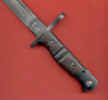
The crooked "W" M1917 bayonet.
Saddlerís Knives
A while back I wrote a short knote about Landers, Frary & Clark and the
knives they made for World War One. In that piece I noted they made 2,500
saddlerís knives. I also noted I had never seen one and really wasnít sure
what a saddlerís knife was. Well you responded in force to tell me what one
looked like. In fact several of you pointed out it was shown in the photo I used
to illustrate the story! I would like to take this opportunity to thank you all
for the wonderful response to tell me what one looked like. While it had my
attention I started too look for other examples. In the World War Two era War
Department Technical Manual TM 9-867, Maintenance and Care of Hand Tools dated
19 April 1945 the saddlerís knife shown is vastly different then the one shown
in the World War One photo. Out of all the responses I received, all pointed out
the WW I version. So in the interest of further education for us all, here is
the updated version of a saddlerís knife. Our good friend Mike Silvey pointed
out that he still uses the WW I version in making his leather scabbards, says it
is very user friendly and aids in quick cutting of the leather.


Gerber Mark II
The prices on these puppies are sky rocketing for mint examples. The Orange
and Yellow handle versions are very rare and often associated with exotic
special units and locales so that all adds up to big bucks for collectors but
why are the run of the mill gray handle versions also out distancing the rest of
the commercial Vietnam Era knives? Much of it is romance and much of it is
nostalgia, the Gerber Mark II fits the niche perfectly. The timing was perfect,
in 1966 the Viet Nam War had gotten deadly serious for the American Army. The
opening presented itself for a sturdy, lightweight, practical knife of the
highest quality but affordable to the average trooper. The choice was a dagger
designed for sticking, but equally capable of cutting and slashing. The Mark II
design was based on a sketch sent in by Army Captain C. A. "Bud"
Holzman. It is curious to note that the Mark 1 Gerber was not designed until
1976, that is after the Vietnam War was over and a full ten years after the Mark
II was produced. Perhaps they were playing on the Mark 2 known to all the
Vietnam era fathers that they carried in WW II, better known as a k-bar? Anyway,
the concept of the Mark II is a descendant of several World War II dagger
models, such as the British Fairbairn / Sykes Fighting Knife and the Case V-42
designed and produced for the First Special Service Force. The blade of the Mark
II is much more robust then the former two and much more reminiscent of the
Randall Model 2 Fighting Knife, perhaps this is the reason for the
"II" model designation? The forged double-edged blade great, while the
cast-in-place hot molten metal sprayed aluminum grip was nearly indestructible.
The knife was supplied with a quality leather sheath, and had an accessory
sharpening steel in a sheath pocket available as an option.
While Holzman's sketch is often called the inspiration, the final design was
probably done by Francis "Ham" Gerber according to Bernard Levine who
also credits "Ham" with the design of the Fh line of Gerber knives.
The knives themselves are produced on the premises of the Gerber plant but
the forged blades were supplied by and outside contractor as Gerber did not
possess the forging capabilities. Handles were cast on in the Gerber plant and
the grinding, glazing and painting were all hand done in the Oregon plant. At
some point the knives were supplied to various PXís around the country and
eventually around the world. Many of the knives were supplied with a small
bottle of cold blue solution so the individual owner could darken his blade if
wanted. Not many knives are noted with blued blades today but if one is seen
this is probably how it got that way. The first knives had the canted blade to
allow the knife to hug the body better. This was not a very long lasting idea as
many of the knives were returned to be "straightened." Many stories we
hear today speak of the knife cant being for the easy targeting of the enemy
kidneys, donít know haw that one started but like all urban legends it still
presents itself as fact. The idea was to hug the body of the wearer to prevent
hang-ups and snags in the boonies. Although the knife was supplied with the
hooks needed to mate with the US pistol belt the favorite place for the Mark II
was on the shoulder strap of the web gear. Hung upside down and ready for quick
action it was the center of attention on many soldiers. In fact one Gerber knife
played a role in a Medal of Honor winning fight. Staff Sgt. Jon Cavaiani used
his Gerber Mark II to dispose of two North Vietnamese in the battle for Radio
Relay Site Outpost Hickory. Although the Staff Sgt. was ultimately captured, the
Gerber served him well when he needed it the most. Along with the ordinary
private purchase knives are the select few purchased and engraved as award
knives to be given to the honor graduates of special schools in Vietnam. Lucky
indeed is the collector who happens upon one of these knives. Very few were
made, they are highly documented and serial numbered to prevent forgery. All
this adds up to the mystique surrounding the Gerber Mark II, I guess thatís
the reason the prices are sky rocketing after all.
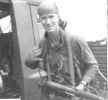
Jerry "Maddog" Shriver
November 1942
I just picked up a book today titled Carlsonís Raid: The Daring Marine
Assault on Makin by George W. Smith. Havenít read the first page yet but I did
leaf through the pictures. One of them caught my attention. It is a common
picture of a group of Marines playing cards, nothing special about that. What is
interesting is the place is Guadalcanal and the date is November 1942. That in
itself still would not be anything special except that one of the Raiders is
wearing a 1219C2 Fighting / Utility knife on his belt. We have long thought that
these knives never made it to the fighting until a bit later then this. In fact
the end of November is always credited with the adoption of this knife type.
This leaves us with two conclusions, either the picture is misdated or the
1219C2 made it to the islands much earlier them we think. While the former if
very possible I have long thought the latter is correct. In fact I think there
was a 1219, 1219A, 1219B, 1219C, 1219C1 and then the 1219C2 in the design family
tree. I have nothing to back it up with but the thought still exists.
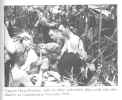
November 1942??
The Continuing Saga...
The latest on the USMC plight to obtain bayonets for the troops. Now we have
the list of makers who have replied to the proposal in the Commerce Business
Daily. Listed below is the latest post on the government web site. Many of the
company names will be familiar to you and many are unheard of companies in the
knife making industry. So far nothing on the actual proposals but when they are
available we will bring them to you right here. Stay in touch for the next
chapter of.... Government Red Tape.
BAYONETS
Latest Update:
18 December 2001
Phase: Pre-solicitation
Status of Effort: Market Research
Available Documents: RFI Respondents (See Herein)
Acquisition Strategy: Commercial Item Acquisition
Next Event: Draft Request for Proposal (RFP)
The information on this page is non-binding and is presented in the interest
of providing the vendor community in general, and potential offerors with a
greater understanding of the intent of this procurement. Your inputs and
comments are solicited and we welcome the opportunity to respond. All relevant
information affecting this procurement will be posted to this web page and
updated regularly. Interested parties are reminded that only the solicitation
document is binding with respect to government requirements.
Initial Posting: 18 December 2001
General Information: The Marine Corps Systems Command (MARCORSYSCOM) is
currently finalizing requirements for the commercial purchase of a new bayonet.
This effort will be accomplished as a commercial item, competitive acquisition
as defined by FAR 2.101. An Indefinite Delivery/Indefinite Quantity (ID/IQ)
contracting strategy is planned, to provide flexibility in ordering and options
for varying quantities. Commercial manufacturing and testing standards,
processes and treatments for hardening and durability, and best practices for
shipping and support are all considerations in developing this requirement.
Offerors will have the latitude to provide unit pricing based upon delivery
quantities and manufacturing schedules that are conducive with their business
strategy while affording the government economies of scale associated with
ordering.
Risk Reduction Strategy: Extensive market research is being accomplished to
ascertain bayonet availability and pricing. The intent of this procurement is to
leverage qualifications possessed by vendors with core capabilities in the key
risk areas of weapon integration (i.e., M16 and M4 rifles), ergonomic design and
safety, and product quality. The USMC will focus on capable products that also
incorporate sound business strategies, thereby reducing aggregate risk to both
vendors and government. As such, the following guidance will remain at the core
of this procurement:
1.) Performance objectives, not thresholds will be established by the
performance specification.
2.) Allow vendors to provide evidence of the viability of their commercial
products previously accomplished testing, and customer base as key elements of
their proposals.
3.) Innovative business strategies, along with technical performance
capability are encouraged.
Teaming by interested parties, such that the key risk areas are mitigated or
abated is encouraged. The following vendors responded to the RFI published by
this Command in the November 30th edition of the CBD:
Responding Company:
Ontario Knife
Company
Lan-Cay
Inc.
Gerber Legendary
Blades
Advanced
Machining
Camillus Quality
Knives
Eickhorn
GMBH
TiKnives
Inc.
Berrizargo,S.L.
Capco
Saber Tech LLC
Queen
Cutlery
Mission Knife and
Tool
Buck
Knives
Knives of
Alaska
Schrade
Cutlery
Benchmade
Knives
TTF Inc.
Currently, the Marine Corps anticipates a Request for Proposal (RFP)
utilizing FAR 12.603óStreamlined Solicitations for Commercial Items. Prior to
formal release of any RFP, a draft Statement of Work (SOW) and specification
will be posted to this web site for industry review and comment.
At this time, questions regarding this effort should be addressed to Ms.
Peggy L. Hake, 703-784-5822 Ext. 240. She will forward your communications to
the appropriate parties (i.e., technical representative, etc.) and ensure a
timely response. Please continue to check this web page for future updates.
E-mail: Peggy L. Hake at hakepl@mcsc.usmc.mil
Commander
MARCORSYSCOM
Attn: CTQ-PLH
2033 Barnett Ave., Suite
315
Quantico, VA 22134-5010

Will they look like this??
A Model 1917 Ĺ Trench Knife??
This is a strange one. I have never seen one like it before nor have I seen
one documented anywhere. And although I do not have an answer to the M1917 vs.
M1918 question that I believe is proof positive which is which I feel this one
may fall somewhere in between. The knife is completely unmarked. The blade is a
typical M1917 / 1918 triangular type, blued and exhibits the typical drag marks
from insertion into and extraction from the Jewell 1918 stamped tubular
scabbard. The handle is the typical dark American walnut common to the other
knives of this genre. The difference being the screw inserted into the top of
the handgrip most likely used as a locking device to hold the knife together.
The knuckle guard is completely different in all aspects. The steel used is
slightly thicker. The flanges are much smaller then the typical guard but the
construction seems to be the same in the bending of the larger flat sheet to
make the flanges protrude. The pommel is a well rounded knob without the spanner
holes used on the screw top models or the peening used on the LF&C peened
pommels. This is the reason for my thoughts on the screw from the top being the
device used to hold the knife together. The only way to find out is to remove
the screw and try but alas the knife is not mine to do so. We show it here for
your (and my) information only. Can anyone tell me what it is??



From the Homer Brett Collection
A New Book
I always have a stack of books on the shelves waiting to be read. The next
one to be read when the current one is finished. Sometimes I skip around but
rarely. This one was different, once I picked it up I couldnít put it down.
Upon itís arrival when I unwrapped the shipping container I glanced through
the pages to make sure it was O.K. and I was struck, I started reading it
immediately while my current book was left sitting half finished on the end
table next to my favorite recliner. Reference books rarely do that to me, I use
them almost everyday but I do not sit and read them through from cover to cover.
And I might add this one was a bit out of my interest area so it was all the
more surprising. Being a United States Military knife collector I was a bit
apprehensive about the contents but that quickly vanished once I started
reading. The book is:
"The Sword And Knife Makers of
Germany 1850-2000, Volume 1, A-L"
by Anthony Carter. The book
starts off by telling the background and history of the famous cutlery town of
Solingen. Interesting in itself the history is just the setup for the
information packed into this book, and I do mean packed. Several years of
research along with the active co-operation of leading Solingen based knife
making companies and their archives have led to a book of markings and codes
unequaled by anything I have ever seen on the subject. Included are suppliers to
the industry not just the makers themselves. If you supplied a grip material you
are included, if you were a retailer you are included, you forged blades only...
included. This part hits very close to home as the most well known retailers
active during the American Civil War sold Solingen made swords, knives and
bayonets, they are included. Those interested in bayonets of the world will be
even more surprised as Solingen exported all over the world, be it a British,
Danish or even Cuban used item the markings are here. While I admit to knowing
very little about said markings I am well aware of the Eickhorn Squirrel
marking. Did you know the Eickhorn has over 60 variations on their trademark
stampingís? The volume contains 1600 trademarks and 1400 brand names along
with maps of the knife-making capitals in Germany. This is indeed a monumental
reference book well worth the cost and should be on every knife collectors shelf
even if you only have a passing interest in German made blades. I felt the same
way myself, now I canít wait to receive Volume II M - Z when it is released.
Never again will you wonder who made that Solingen stamped knife! It is a 288
page hardback, ISBN 0-946696-31-4
Available through
Tharston
Press
Morton Hall, Morton on the Hill
Norwich NR9 5JS,
England
Telephone
01603-881346
www.tharstonpress.co.uk
sales@tharstonpress.co.uk
Get one, you wonít be disappointed.

Condor Marked Knives
Iím asking for help again on this one. Pictured below are three photographs
of a knife said to have been recovered from a shot down airman or pilot during
the Korean War. The knife was found along with other personal effects and held
by a Russian Advisor until his death. The current owner would like to repatriate
this knife with the former owner or relative. We are trying to determine the
correct age and maker of this knife. Any help would be greatly appreciated by us
and the U.S. - Russian Commission on POW / MIAís in Russia. Any information or
clues are welcomed, even a guess may help find the answer. Waiting to hear from
you. Thanks in Advance! Frank. E-mail me at trz@citnet.com
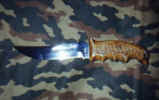
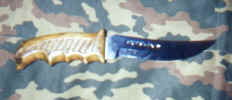

Knife with "CONDOR" marked in the fuller. Can you
I/D this knife?
Old Trivia Question
Well this is the second month in a row we have not had a correct answer. Too
hard I guess. The correct answer was Sands of Iwo Jima. Record it and play it
slow during the landing and fight up Mt. Surabachi and you will see several
scenes with the knife prominently displayed. Again I thank Dick Boyd for that
question.
New Trivia Question
What is the correct name and model number for the Western States Cutlery
& Manufacturing Co. so called V-44 according to Western advertising?
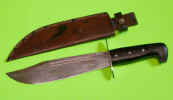
As always the first correct answer wins a free USMILITARYKNIVES.COM tee
shirt.
A Classy Lady
In most cases I refuse to forward e-mail of the chain letter or spam type.
Again in most cases the content is not correct, contains mistakes, lies or has
been so twisted that the intended point is all but lost. Here is one I received
and checked out as best I could. It seems real enough and concurs with other
stories of the same type. Nothing to do with knives but here for your reading
pleasure:
3/66 First tour of performing in Vietnam.
12/22/68 Goes with Bob Hope Show for second tour of Vietnam
There is Justice: Ann-Margret and the Vietnam Vet
Richard (my husband) never really talked a lot about his time in Vietnam other
than he had been shot by a sniper. However, he had a rather grainy, 8 x 10 black
& white photo he had taken at a USO show of Ann-Margret with Bob Hope in the
background that was one of his treasures.
A few years ago, Ann- Margret was doing a book signing at a local bookstore.
Richard wanted to see if he could get her to sign the treasured photo, so he
arrived at the bookstore at 12 o'clock for the 7:30 signing. When I got there
after work, the line went all the way around the bookstore,
circled the parking lot, and disappeared behind a parking garage.
Before her appearance, bookstore employees announced that she would sign only
her book and no memorabilia would be permitted. Richard was disappointed, but
wanted to show her the photo and let her know how much those shows meant to
lonely GI's so far from home.
Ann-Margret came out looking as beautiful as ever and, as 2nd in line, it was
soon Richard's turn. He presented the book for her signature and then took out
the photo. When he did, there were many shouts from the employees that she would
not sign it. Richard said, "I understand. I just wanted her to see
it."
She took one look at the photo, tears welled up in her eyes and she said,
"This is one of my gentlemen from Vietnam and I most certainly will sign
his photo. I know what these men did for their country and I always have time
for "my gentlemen." With that, she pulled Richard across the table and
planted a big kiss on him. She then made quite a to do about the bravery of
the young men she met over the years, how much she admired them, and how much
she appreciated them.
There weren't too many dry eyes among those close enough to hear. She then posed
for pictures and acted as if he was the only one there.
Later at dinner, Richard was very quiet. When I asked if he'd like to talk about
it, my big strong husband broke down in tears. "That's the first time
anyone ever thanked me for my time in the Army," he said.
Richard, like many others, came home to people who spit on him and shouted ugly
things at him. That night was a turning point for him. He walked a little
straighter and, for the first time in years, was proud to have been a Vet. I'll
never forget Ann-Margret for her graciousness and how much that small act of
kindness meant to my husband. I now make it a point to say "Thank You"
to every person I come across who served in our Armed Forces. Freedom does not
come cheap and I am grateful for all those who have served their country.
If you'd like to pass on this story, feel free to do so. Perhaps it will help
others to become aware of how important it is to acknowledge the contribution
our service people make.
A proud wife, Barbara


Navy MK-V Dive Knives
We spoke about them a little in the past few months but nothing in depth. I
am in the process of trying to collect information on them for a forthcoming
article. Any information, documents, anecdotes or photos would be welcome, with
proper credit given of course. These things are hard to find information on.
Seems they have always been there but nobody knows for sure when they started of
how many have been supplied and by whom! HELP! Thanks.
The "AN" Marked M6 Bayonet
Our good friend Greg Robinson is on a hunt. I have tried to assist him with
our limited knowledge on the subject and along with another good friend Gary
Cunningham we have tried to crack the case. Still at a dead end though. So far
several assumptions are in play and trial and error still prevail. When the M14
was adopted there was a big discussion in the Army Ordnance Department as to
whether or not we really needed a bayonet. (That in itself is another story as
this discussion has taken place since the invention of gun powder and is raised
again at every newly invented ignition system and magazine capacity increase!)
During development of the M14, which took from 1945 to 1957 in testing various
models, we believe an M5 bayonet was used as a model with the M6 type fittings
being installed to fit the new rifle. Perhaps the work was done at Anniston
Arsenal in Alabama who used the government markings of AN on all of their
rebuilt pieces. Again this is all theory so far. The prototype for the M6, the
T12 was developed at Springfield Armory so why would Anniston be involved? We
canít answer that one just yet. Can you add anything to this?? Bits and pieces
are welcome as are guesses!
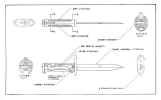
T12 development drawing prior to becoming the M6
Updated 02/02/02
Who said this??
"It is a paradoxical truth that tax rates are too high
today and tax revenues are too low, and the soundest way to raise the revenues
in the long run is to cut the rates now. The purpose of cutting taxes now is not
to incur a budget deficit, but to achieve the more prosperous, expanding economy
which can bring a budget surplus."
(Probably not who you might think. Skip
down to the bottom for the answer.)
The Crystal Ball Effect
The most often asked questions I seem to receive are:
What do I have? What is it worth? Will it increase in value / Should I keep
it?
Most come from folks surfing the web and coming across my page here, they
often think I have a crystal ball. The second question is usually the easiest.
Current value has become easy in most cases as a simple search will find you the
information if you know where to look. Start with completed auctions in ebay or
another of the current on line auction houses. Then migrate to some of the
forums currently operating and look in the "for sale" sections. They
give a good indication of the current value. You may not agree with it but if
they sold then that was the assumed value by at least one person. After that it
is a matter of hitting the gun and knife shows to look. Donít just look at the
asking prices, that piece may have been laying on the table for a decade. Just
because a "dealer" prices it too high does mean he will get it. On the
other hand if a dealer prices it too low donít expect to find another one for
that same low price, probably wonít happen.
For the first question I would suggest the same as the above but add in
purchase a few books. Suggested reading can be found on the Books for Sale
pages. Then comes the big commitment, pick up and examine every knife you see
for the next ten years or so. It helps with identification to have actually seen
the knife not just a picture of what one should look like.
The third one is the hardest, my crystal ball says that any knife is likely
to hold its value and keep up with inflation as long as it's in production. Duh!
Another easy call is when the knife undergoes an enhancement does the world
think it is better or worse? If better the prior model will not be wanted and
value will go down, if worse the prior model will be searched out for itís
qualities adding to the value. Duh again! Other then that your guess is as good
as mine, hell it may be even better then mine. In older collectable knives the
main deciding factor is condition. A mint knife will almost always appreciate in
value, in fact it is almost impossible to pay too much for one these days the
way items are being snatched up to avoid the stock market with itís low return
and high risk. Another part of the equation is the intrinsic value of the item.
If it was Uncle Harryís knife it is usually more valuable to the family then
an outsider who did not know Uncle Harry. They are the most dangerous appraisals
to handle for someone. The sentimental value is hard to put a price on. I
usually tell people it is worth more to them as a valuable family heirloom them
to put it out on the street to some unknown. In other cases it can be very hard
to tell someone that "Dadís" knife he carried throughout WW II was
made in 1976 or something like that. I try to be easy but it never works out
that way. Last but not least if the market drops and everything in your life
comes to a stand still, you can still use the knife to cut with, providing you
are willing to sharpen that rare mint collectable!
What do all those Tís, Eís, Aís and Mís Mean?
As weapons are the basic equipment of an army they are the most common items
to be modified and modernized. When existing weapons are proven to be inadequate
they are updated by means of improvement or a totally new design. This was
probably most apparent during World War Two as the full thrust of American
technology and industrial might came to bear. Improvements in the weapons and in
production necessitated the modernization of our stocking system and cataloging
through temporary and permanent designations. This is where the above
designations come into play. The system of designating items with alpha numeric
classifications provides a clue as to the amount of research and development
that lies behind each approved model of a particular weapon or weapon system.
Depending upon what stage they are in of development, the items may be assigned
a temporary alpha numeric designation in experimentation and another permanent
number in standardized life. With that all said lets get to the meat of the
discussion, the designators.
The E designation stands for Experimental model.
The T designation is the next higher level and indicates testing.
The M designation denotes the item has been adopted for use.
The A designation along with the M states a modification has been made to the
adopted model.
Lets run through a few examples of the system:
E10 would designate the tenth experimental item of that line.
T8E10 would designate the tenth experimental model of the eighth test type.
M26 would designate the twenty sixth adoption of a weapon or system.
M26A1 would designated the first modification of the twenty sixth model
adopted.
Hence we have the M1905E1 being the first experimental model of the adopted
M1905 bayonet. We have the M8A1 being the first modification of the adopted M8
scabbard. The T12 was the test bayonet which became the M6 when adopted into
standardization so we can see the temporary alpha numeric designation completely
changing to the permanent designation. There doesn't seem to be a hard date to
when the US changed over from the Model designator being the year of adoption to
a standard number. We see the M1 Garand being adopted in 1936 and given the
first single number designator while the M1941 Johnson came about with a date
designator as did the adopted combat shotguns of WW II. The Thompson Sub Machine
gun was first adopted by the Army as the M1928A1, a date designator and later
purchased for WW II as the M1 and later yet as the M1A1! Why did they change the
Thompson and not the M1903 Springfield which went through the M1903, M1903A1,
M1903 MOD., M1903A3, M1903A4 and never changed into the non date designation? I
guess that is another discussion for another day.
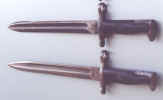
M1905E1 Bayonet
Baxter Knives
Sidney R. Baxter & Co. Boston Ma. made industrial machine knives. They
also made "combat knives" during World War Two. One design was a blade
inserted into a "mill file" handle. They used brass guards and pommels
with red fiber slab handles on most of the fighting knives. Other then the
photos in various books, Cole, Silvey etc., that is about the extent of my
knowledge on Baxter knives. What can you add to that?

Two WW II Era Baxter Knives
Hicks
In a debate with our good friend Bernard Levine he contends that Hicks knives
were not military. I have read through those Allegheny Arsenal Letter Books that
are supposed to hold the reference to them being purchased by the military but
could never find that passage Peterson attributed to them in his early reference
"American Knives." Without that passage I too contend they were not
made for the military but for private purchase. While surfing the Ďnet looking
for references with Hicks I found this one:
This is an authentic Springbok Jigsaw Puzzle called "Andrew Hicks on
Hatteras Ground". Copyright 1972. 500+ pieces. 20" x 22 9/16".
This is a painting by Frank Vining Smith from the Mariners Museum, Newport News,
Virginia. Picture is of the Andrew Hicks ship which was built in 1867.
Here we have a sailing ship named the Andrew Hicks, surely not the same
Andrew we are searching for but a hit still the same. Can you prove to me that
the military purchased the Hicks Bowie knife for issue?? I would love to hear
that story.
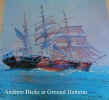
The Puzzle
Murphy's Laws of Combat in Latin.
As you faithful followers of my ramblings are aware, I love a good quote.
While not a quote the following is fairly close and is profound enough to add to
our discussion list.
If the enemy is in range, so are you.
Si hostes visibilis, etiam tu.
Incoming fire has the right of way
Missiles invenientes semper potestatem viae habent
Don't look conspicuous, it draws fire
Noli eminere, catapultas allicies
There is always a way
Putamus viam semper esse
The easy way is always mined
Via perfacilis laqueis semper plena
Try to look unimportant, they may be low on ammo
Conare nullius momenti videri fortasse missilibus careant
Professionals are predictable, it is the amateurs who are dangerous
Peritissimos semper praevidere possumus, rudi autem periculosi sunt
The enemy invariably attacks on two occasions:
(a) when you are ready for them, (b) when you are not ready for them
Duobus temporibus oppugnant hostes: cum parati estis, et cum imparati estis
Teamwork is essential, it gives them someone else to shoot at
Collaboratio maximi momenti est, quia eis alterum scopum praebet
If you can't remember, the claymore is always pointed at you
Si id memini non potes, scutula dirumpens semper at te collineata est
The enemy diversion you have been ignoring will be the main attack
Negligentia hostium quam non coluistis primus impetus erit
A sucking chest wound is nature's way of telling you to slow down
Vulnus pectoris sugens ne properetis mos naturae dicendi est
If your attack is going well, you have walked into an ambush
Si impetus bene it, in laqueum incessistis
Never draw fire, it irritates everyone around you
Numquam catapultas allice, iram omnium concitabis
Anything you can do can get you shot, including nothing
Ex quocumque facere poteris te sauciabit, nihilo comprehenso
Make it tough for the enemy to get in and you won't be able to get out
Si hostibus difficile incedere facias tu quoque male extricabis
Never share a foxhole with one braver than yourself
Numquam fossam compartire cum viro tibi fortiore
If you are short of anything but the enemy you are in a combat zone
Si nihilo carueris nisi hostibus loco pugnae es
When you have secured an area, don't forget to tell the enemy
Si locum inexpugnabilis facias, memento hostibus de hoc profiteri
Never forget your weapon is made by the lowest bidder
Numquam obliviscaris tua tela facta ab eis qui minima liciti sunt
(This one drove my spell checker over the edge!)
Ames Swords
We were sent the below newspaper clipping. Makes for good reading.
From the Boston Mercantile Journal, Oct. 1, 1839:
THE ESTABLISHMENT OF THE AMESES - We have very cursorily mentioned the
beautiful table of N.P. Ames, which occupies a conspicuous place, as it well
deserves one, in the centre of the rotunda at Quincy Hall, and attracts a
continual crowd of admiring spectators. This show is somewhat novel; to some
extent unique in our country, as well as in this exhibition...
It may not be generally known that there is no other regular sword
manufactory in the United States. There never was one, to our knowledge,
excepting a small concern set up at Middletown (Conn.), we believe, during the
last war, and which ceased its operations very soon after. Swords, to be sure,
are occasionally got up elsewhere. There is a German at Philadelphia who
finishes some imported blades; and Fletcher, the silversmith, of that city,
does one to order now and then, just as our neighbor Mr. Jones would, we
suppose, on a pinch; and especially if he got $7,000 for it, as Fletcher did
(they say) for the sword given by the Legislature of New York to Col. Worth of
the Army; or $1,000, which was the cost of one presented not long ago to Gen.
Brady at Detroit. This, by the way, is the greatest cost for a home-made sword,
we have heard of. General Macomb has one, a present also, of the $700 style. The
Ameses made one lately at $500. for Capt. Turner, now of the frigate
Constitution; that is, for the parties who made a gift of it; and they are just
now finishing up half a dozen, which are to be presented to as many officers,
who distinguished themselves in the last war, by the Legislature of Virginia. We
have been surprised to learn how much of a business grows out of these presents,
and how many more out of prizes for target-shooting, and so on. They are not,
however, made so costly as these we have named, but more generally from one
hundred dollars to two; and for that kind the Ameses have a very considerable
and a constant demand. They have recently made a $125 sword, which has been
given by one of the Salem military companies to Captain Sutton of that city.
These gentlemen furnish the United States army with their swords, by contract
with the Government, which amounts, we believe, to some $4,000 yearly,
including, no doubt, what are stored, and what are furnished in quotas to the
States. The officers order their weapons where they please, only following the
national pattern; but not a great many are ordered to be imported. Generally
they order their service-swords of the Ameses - a very handsome article, though
not above $20 in cost - specimens of which may be seen at Quincy Hall. In that
collection we notice one also, ordered by Captain Moore, now commander of the
Texan navy, adorned with the national magnolia, and got up altogether in
beautiful style, with silver mountings, though not costing probably above $50,
and so by no means, an extravaganza for the naval chief of so mighty a nation as
that - is going to be. The same gentleman has ordered another article, more
substantial - a boarding-sword, elegantly finished - but having the weight and
formidable aspect of a pick-axe, or of that far-famed Drontheim
"star," wherewith the worthy watchmen of Norway last season thought
proper to beat in the thick skull of the riotous Marquis of Waterford. It would
do no good, at all events, in a close grapple; probably a bore, rather. The
same must be said of the bowie-knife on this table - the only one in Boston we
hope - for a most terrific utensil it certainly is. These, Mr. Ames says, are
not very marketable, though he has tried his hand at a few.
Mr. A. showed us an article more to our fancy, which is ordered by a Southern
gentleman, as a present to "John Trezevant Wigfall," doubtless a
military personage. This is a splendid sword, rated at $250, but we have no room
for describing it. We can merely mention, also, the new and beautiful pattern
intended for the United States Topographical Engineers; the dazzling
fancy-sword, fitted for the stage - such as Macready likes to wear, and such as
Forrest does wear......it is too good a fact to be lost, that the swords sent
out to England some years since by the Ameses, or by some of their customers,
were not only imitated as exactly as possible, and at once, by their
manufacturers, but thought so well of, that the counterfeits came back to this
country with even the name of "N.P. Ames" upon them. This was a daring
move, and has been discontinued, but we understand the pattern comes constantly
still, though without the name. So much for American ingenuity. The compliment
may certainly be appreciated, though the trick must, of course, be despised.

The Ames Logo
Last Months Trivia Question
What is the correct name and model number for the Western States Cutlery
& Manufacturing Co. so called V-44?
Answer: The Bushman Model No. Bx54
The first correct answer was supplied by Dick Boyd. We had a large number of
answers this round, thanks! Dick received his U.S. Military Knives . Com Tee
Shirt for that lightning fast reply.
New Trivia Question
During World War Two John Ek Mfg. Co. was located in Hamden Conn. What was
the street address they were located at?
As always the first correct answer wins a U.S. Military Knives . Com Pocket
Tee Shirt mailed straight to your door. Good Luck
1955 Krag Bayonets
We have recently been informed by our good friend Dick Boyd that Chrome
plated Krag Bayonets were produced by Rock Island Arsenal as late as 1955. These
items were used by the U.S. Military Academy at West Point until 1962 when they
switched over to the M14 Rifle which mounted the M6 bayonet. You see the Krag
bayonet and locking system fit the Krag rifle, the M1903 Springfield rifle and
the M1 Garand rifle, a fact that is little known. The shorter Krag bayonet
balanced better and looked smarter on the Cadet Parade ground. The black metal
scabbard with hook also better suited the cadet uniform with the black scabbard
body and the locking hook which could fit over the white dress belt of the
cadet. I had seen a reference to 900 being ordered in WW II (Bayonets, Knives
and Scabbards, yes a plug for the book!) but never as late as 1955. In a letter
from Rock Island in Dickís possession we find they confirmed the production.
The letter, dated 30 March 1979 from Department of the Army, Rock Island Arsenal
states that "the M1898 dress bayonet and scabbard is from the last group
made at RIA in 1955. When West Point began using the M14 Rifles, these M1898
dress bayonets were offered for sale to former graduates of West Point. The
piece under the belt loop of the scabbard is a safe made of black leather."
We are unsure of the markings but seem to be "RIA B-136C" on the
ricasso. It does not seem to be a stamping according to Dick. So there we have
it, you read it here first. Krag bayonets, some 100 years old be refurbished for
the Corps of Cadets. They also stated that some of the bayonets have been
refinished as many as 5 times! Shorter and rounded blades are normal for a
refinished cadet model so do not worry if yours appears to be shorter them the
proscribed length, it is a common occurrence. Our deepest appreciation to Dick
Boyd for sharing that with us.
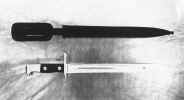
A Photocopy of the Photo.
While on the subject of Kragís
We hear from our good friend Gary Cunningham that he has observed 9 Krag
bayonets all dated 1900 with a strange bluing on them. Not a high polish as we
will discuss in a future description of how blue was applied at the arsenals and
armories. This is more of a dim, swarthy blue - gray but not like a Parkerizing.
All of the observed bayonets have properly installed grips that have not been
played around with. They have the correct and standard domed rivets which make
them appear to have been depot finished. The truly peculiar part is that no
other dates have been observed with the dark dull blue finish. Gary relates to
us that he has heard from other collectors that these were from a quantity done
in Manila for use in the Philippines. Nothing in writing and purely speculation
but it is a thought as the Philippines Department was experimenting with
bayonets at that time and we know they had some work done to a few M1898
bayonets to modify them into bolo bayonets. These were forwarded to the Ordnance
Department to test and duplicate for conceivable future issue. So it is feasible
it may have been executed there. It is also possible they were finished in
someoneís garage in 1953 along with the touch up on the Western Field 16 gauge
double gun. We would love to hear from someone who could cast a little light on
this one!
Cole III is Going Out of Print
We recently learned that IDSA Books is going to let U.S. Military Knives
Bayonets & Machetes Book III go out of print. It will join Cole IV already
in that status. While this may not affect collectors already established it will
greatly affect the arrival of the new collector. Call or write to IDSA and
politely ask that they reprint, or sell the rights to someone who will, if they
believe it to be a money loser.
A so called friend...
Wandering around a very large knife show with my wife we were approached by a
good friend. The fellow wanted to speak to my wife and give her his card. Just
as plain as day he said "Give me a call if you want to get even with him or
if he dies." I started to laugh as did my wife, he wasnít laughing, just
wanted first shot at my possessions. I locked my stuff up real good when I got
home!!
XM9 Eickhorn Test Bayonet
This is my latest toy to be gathered up. One of the original test bayonets
for the M9 bayonet trials. At first glance it appears to be another of the
multitude of Eickhorn wire-cutting bayonets currently available on the retail
market. It is the rudimentary model for the M-16A2, in green with rectangular
handle, and the short bowie blade. The scabbard, also green, is in fact for the
longer version of the Eickhorn products with a detachable clip at the frog. This
allows the quick release of the scabbard to mate with the bayonet blade to
fashion the wire-cutter. One can only guess that the longer scabbard was
intended to contribute more effective leverage for wire-cutting. While most may
think this is "high tech" and "trick" I think it is a waste
of time. The typical soldier will need a wire cutter like I will need another
hole in my head. Just a gadget to increase the price of a basic article of
equipment. A pair of wire cutters from the hardware store work much better,
faster and noiseless. The pommel, guard and blade are all finished a bleak,
non-reflective, black. The part that makes this bayonet distinctive is the
markings. The blade is unmarked save for an engraved "6."
(Eickhornís ID Number for the trials) on the reverse ricasso. The reverse side
of the grip, near the guard is hand engraved "C 2" with an electric
engraving pencil as is the front of the scabbard near the throat. This indicates
that this was bayonet number C 2 tested. The "NU - 59" painted on the
scabbard is a code for a insufficiency during the test, in this case a cutter
plate complication. Overall length of the bayonet is 12" while the blade is
6 3/4". Total length in the scabbard is 15 Ĺ".
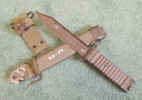
My Newest Toy
My Springfield Armory Trip
I was fortuitous enough to be traveling through Springfield Mass. so the
prospect of a sojourn was absolute. It has been a while since my last visit and
this time I was prepared with my digital camera. This is a great arms display
and I wanted a few pictures to display here. I couldnít get any of the
information I was looking for from them at the time but I have a letter in the
works. Well nevertheless here are a few pictures of some of the preeminent
bayonets to be found anywhere....
Armory
Photos Page
ABC Forbids the Red, White & Blue
Did you know that ABC News has asked its staff not to wear American flag pins
in their lapels, or even red, white and blue ribbons, in an effort to protect
their credibility as objective sources.
"We cannot signal through outward symbols how we feel, even if the cause
is justified," said ABC spokesman Jeffrey Schneider. "Overseas, it
could be perceived that we're just mouthpieces for the U.S. government, and that
can place our journalists in danger." I never noticed that statement when
everyone was wearing a red ribbon to align ones self with the AID'S. awareness
campaign, makes me wonder sometimes?
The Color of Money and Knife Blades, Parkerizing!
At a recent gun show I stood back and watched a fellow scrutinize a WW II era
bayonet. The price was high and the bayonet was mint or as close to it as you
want to find. The price was not the debate, the finish was. The seller had a
mint bayonet, a mint scabbard and a price to match, he was not worried about
selling it. The buyer did not even ask about the price as he examined the blade.
He stated the bayonet was refinished and the "color of the Parkerizing was
wrong" for the particular maker. He put it back down and walked away. I
looked at the bayonet afterwards and could not find any indications it had ever
been touched let alone refinished. In about 10 minutes the fellow came back with
a friend to look at it again. The friend pronounced it an "amazing"
find but the original fellow then told him about the "color" problem.
They agreed on that and wandered off. It left me scratching my head. Is this
possible to tell original items by the color of the Parkerizing? In a perfect
world, yes, in the real world, no. You could look at 1,000 bayonets that are the
same color from the same batch and then one could be off color. The color
process is effected by several things, one of which is the strength of the
solution. Yes it does get weak from use! Did they mix up a new batch just before
quitting time or could they have used the same batch for the last few bayonets?
Type of steel, steel from a different melt, temperature differences in forging,
tempering, straightening procedures, water density, water purity, age of the
pipes in the plant, solution mix strength, etc. all add up to possible
variations in color. I contend that you can not disparage an original parkerized
bayonet, or for that matter any item parkerized, by the color I donít care how
god damn good you are. I have seen green, gray, brown, black and red parkerized
bayonets from the years. Other than off-colors such as a bright silver or a
solid black, it is all but impossible to tell the originality of Parkerizing
without a detailed, physical inspection beyond the color. Upon that inspection
you need to look for a grainy texture of the finish and rounded or buffed
markings, that can tell you something is wrong not the color. To keep rifles the
same color Springfield Armory eventually used a dye in the final oil coating so
they would not raise a concern over the color issue. The Parker Rust Proof Co.
was the main provider to the government and all the separate Ordnance controlled
facilities and manufacturers. The same product, "Parko Powder" was
being sold to every manufacturer yet they produced different colors in different
parts of the country. Yes, it is a great indication to look harder if the color
does not look right but as a reason to condemn a piece without further
indications it is crazy.
The Army Uniform
General Tommy Franks of the U.S. Central Command has, this week, declared the
Abaya non-mandatory for U.S. service women serving in the Middle East while off
post or off duty. Many Saudi-based U.S. commanders continue to require it for
female soldiers in the above situations. Abaya or not, the Saudis would be a
newly annexed province of Iraq were it not for the continued duty of American
soldiers, many of which are female. Way to go General, now get all your
subordinates to follow your lead. Do you suppose we could get him to adopt a new
fixed blade for the troops too??
Springfield Bluing Procedures
Just for the record they called it browning not bluing but bluing is what we
know it by. Did you ever wonder how they got such beautiful deep rich colors?
Hard work is the answer. The process according to government instructions are as
follows:
Boil all parts for 20 minutes in lime water to remove all traces of grease.
They were then removed from the solution and wiped free of lime. The next step
is to coat them with the browning mixture which consisted of:
6 oz. Tincture of iron (ferric chloride, anhydrous)
6 oz. Sweet spirits nitre (ethyl nitrite)
1 oz. Nitric acid
1 oz. Corrosive sublimate (mercuric chloride)
Ĺ oz. Sulphate copper (copper sulphate)
2 qt. Water
Mixed in that order which is extremely important.
(Please note these chemicals are extremely hazardous and lethal to humans,
donít try this at home!)
After the parts stood for 15 minutes a second coating was applied and the
parts were placed in a steam cabinet for 16 hours. This produced a fine coating
of rust. The parts were then boiled for 5 minutes to remove the acid traces.
Next the parts were "carded" or wire wheeled. Another coating of the
lethal mixture was applied and the parts were placed in the cabinet for 3 hours
but wet and dry this time. After removal they were again wire wheeled to remove
the built up enhanced rust. A third coating was applied and the parts placed in
the cabinet overnight. After the final rust removal by carding the process was
finished except for a final cleaning and oiling.
So as you can see the browning / bluing process was extremely time consuming
and a lot of work. It was a natural when the Parker Rust Proofing Company came
along with their original, immediate process using their proprietary "Parko
Powder" mix. Sandblasting to clean and etch the exterior. A 30 minute boil
in the phosphoric acid and powdered iron coated the surfaces. After the bath the
products were coated with oil and a black dye to add consistency to the color
and the process was finished. Yeah, a pretty easy decision to convert over for
higher production.
Knife Knotes 2002, A look back
Having written this column for something over six years now, I thought it
time to take a look back at the assorted ramblingís of a knife collector. It
started out as short articles on a common topic per issue. That was O.K. but not
what I really wanted to do. It was for awhile. It did work to gather my thoughts
and place them all in one easy to find repository for future use. Granted it
kept me organized, but it was more restrictive then I wanted to be. I sort of
like rambling, to those of you who have followed me all these years as if you
havenít noticed! The column itself is of no great importance in the big
picture of this ever changing world but none the less it is here for all to see,
finally that place to record my thoughts on the knife.
It all started with the urging of our good friend Dennis
Ellingsen who want to fill space in the Oregon Knife Collectors Assoc.
Knewsletter. For a kid who failed high school English Composition it was a
challenge! Curiosity had bitten me, I recorded all this information for myself,
maybe somebody else really was interested in this material. With only the
obscurest idea of how to do it or even what I was doing, I sent in some
scribbling to Dennis via e-mail. Through the patient and skillful handling of
Dennis and Elayne (the real editors) the work of this amateur
"wordsmith" actually looked like I did know what I was doing, hell it
scared me! It has been fun ever since, I still donít know if anybody reads
this page but it runs here every month with my latest wandering essay.
After several years in print Dennis decided to put all the past chatter I had
written on the Internet, posted to the OKCA site. This was an experiment for the
both of us. I liked what I saw and really liked the way it extended my reach. I
started to receive e-mail from folks not only in the country but from folks
around the globe. It seems that many "search engines" would locate
keywords for you in a fast search throughout the plant and for all I know the
entire universe? I really couldnít explain the Internet to you but I assure
you it is out there, hell maybe Mars has a connection. Anyway I digress, with
this new extended reach and power to put out what ever I wanted I was tempted to
reach farther and with more.
Knowing little of the Internet and nothing at all of running a web site, hell
even where to start I called my local Internet e-mail provider and pleaded
stupidness and asked for enlightenment. His answer to me was the same answer I
give to most coming to me... I purchased a book. A book on writing in another
language ( it is still English but it looks like Greek to me, HTML, the Internet
language that is) learned how the World Wide Web worked just enough to enter it
(curiously enough it works like anything else, you put in enough money and
energy it sort of responds) and joined the world of the Web Sites. Yes I am the
Web Site Owner regardless of what the paperwork might say, another stupid
mistake on my part, not the first and certainly not the last.
So where does that leave me now? It is impossible to say. I canít tell you
how many masses read the site, how many stumble there by accident, or how many
return monthly. I can tell you my e-mail is up dramatically so it is an
indication it is reaching some. I have also searched the web to find my writing
on other folks web sites, with and without my permission I might add. Copyright
means little or nothing on the web, I find items all over the place copied. I
might also add that I donít mind, in fact it makes me feel good when I see
something I had written used on some other site. I get e-mail from folks who
copy my writing and send it to friends, again without my permission, and they
tell me about it! If it is the target audience all the better. In short, I
donít know how many people read this thing. At first my judgment said
"Hey this is illegal, you canít do that." I wanted everyone to come
to my site, thatís what it is there for. Then my better judgment kicked in and
said "Hey dummy, they are readers, this is a good thing." You see my
better judgment talks to me that way, I usually listen. And to be perfectly
honest, I couldnít stop it if I tried, so I learned to live with it, and that
turned out to be the better decision in the end.
Another thing about the net is that I can be brutally honest or for that
matter be a loud-mouthed liar. I paid for the space I can put anything out there
I want. I want to stick to the topic of knives but I occasionally get side
tracked into politics, yes I can proudly wave my flag and thumb my nose at the
world when I want to. And I still love my quotes, so you will find them there.
You see it is like my house and my rules but it is out over the entire world,
way cool! Now if we could just get the Internet to outweigh the Idiot box in
popularity we just might get some even handed reporting not the trash they spew
on the major Networks. Watching the so called "News" is a complete
waste of time, they actually report rumors, the only thing they are accurate on
are sports scores a day or so after the event. Big Deal.
Last but not least is the money. With all the "Dot Com"
billionaires out there I wanted my part of it. The way it is supposed to work is
that you advertise on your site and get paid for those commercials. Well, to get
advertisers you have to get high traffic to your site. In fact if every knife
collector in the world visited my site daily it would only attract moderate
attention from advertisers. To put it bluntly, forget it, "that dog donít
hunt" and there ainít no money for a small time web site that doesnít
have pictures of naked girls on it. So how about charging to enter the site and
read this, yeah right, Hemingway I ainít, 90% of the current readers would
probably leave. So much for being a Dot Com billionaire. So I have returned to
my roots, a hobbyist who gets pleasure from rambling on about knives. Hmmm,
naked girls modeling with military knives... naw my wife would kill me and then
sell all my stuff!
All in all itís a pretty good life!
Tea Anyone??
Did you know the Boston Tea Party was over a 5% tax?
Makes you think doesnít it?
Is it just me??
Treason: treaíson n. treachery; breaking allegiance.
Websterís Dictionary 1988 edition
Treason: trea-son n. Betrayal or breach of allegiance or obedience
toward oneís sovereign or government.
Funk & Wagnall's Standard Desk Dictionary
In reference to the so called "American" asshole they caught over
in Afghanistan, I scratched the word out of both of my reference books. The word
no longer has any meaning. When he beats the rap and gets out of jail he will
write a book on how he was abused as a child and wronged by the government. The
book will hit the best seller list aided by the liberal media and the apologists
which will make him rich. He will still be an asshole, albeit a rich one. Just
what the world needs.
The Answer to the Question Above
The answer to the "Who said this??" question at the beginning is
President John F. Kennedy. Somewhere along the line I believe his brother
Democrats missed the message.
CASE XX Navy Knives
According to our good friend Ron Flook the World War 2 period US Navy knives
were made by W.R. Case and Sons Cutlery Co., Bradford, Pennsylvania, USA between
1940 and 1942 and bore the mark "Case XX" on the blade. (Flook Pg. 191
& 192) He also talks about knives made in the US for the Canadians during
the war marked "Case XX / METAL STAMPINGS / LTD". Again according to
Ron that seems to apply only to alloy handled ones so I don't know what the
steel ones were marked or, if Case made steel handled knives for Canada in WW2.
The post war Pictou knives were marked "M.S.LTD XX" that much we do
know. What can you tell me to add to this most interesting history of Case U.S.
Navy knives? Can you confirm or deny the above??
Henry Disston & Sons
Looking back at the grand old firm we find that they go all the way back to
the1860's. They were once one of the largest employers in Philadelphia employing
up to 5,000 men at the old Saw Works. They were one of the old-fashioned good
guys too, they provided low cost housing for their employees, sponsored
recreational leagues, outings etc., some of the homes they built or financed for
employees are still standing in the Frankford section of Philly. In fact there
is even a Disston Street still in Philadelphia. They were primarily famous for
their saws although we know them best for their machetes, boloís and trench
knives. They still sell saw blades under the Disston name, most being the
circular saw type not the grand old hand saw. They were a very large government
contractor in WW I and WW II. In fact they are credited with the design of the
WW I Model of 1917 trench knife. Unfortunately they went the way of many
American industries in the 50's or 60's when they could no longer compete in the
marketplace due to cheaper competition. I have had quite a few Disston saws over
the years both as users and as collectors items. They seem to be plentiful
around the Delaware Valley area. As in the traditional manor of just about every
thing old or handmade they made a very fine product. Some of their old factory
buildings are still standing and are used as factories and retail sales
facilities down along the river. Quite a sight to see, wish they were still
active to furnish some old records. They were bought out at some point it time
and the Stanley Tool Works acquired the right to the name. Records are long gone
on the 1917 / 1918 era, oh well...
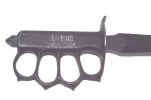
Briddell
A small machete I found recently is 17" overall, with an 11" blade.
Marked near the base of the blade with a pilot's wings logo over MADE IN U.S.A.
/ Briddell / No. 1218. A marking I had not seen before put me to thinking what I
knew about Bridell in general. Not much was the quick answer. A short bit of
surfing led me to this short bio of them. Charles D. Briddell, Inc., was founded
in the 1920s in Crisfield, Maryland, manufacturing knives and other tools for
the local crab and oyster industry. In World War II, Briddell made bolos for the
USMC, as well as a variety of utilitarian cutlery. After WWII, Briddell
introduced a line of steak knives called Carvel Hall, named after a famous
luxury hotel in Annapolis MD. Soon the company changed its name to Carvel Hall.
The firm was a division of Towle Mfg. from 1961 to 1990. According to the site
they are now independent again. What can you add to this???
Hard Hat Dive Knives
We are still looking for any and all information on the brass sheathed dive
knives. Even the smallest bit of information can help. Thanks in advance to all.

Photo Supplied by Ric Koellner of DESCO Corp
Milpar Packaging
Recently found on the side of a package:
1005-722-3097-B008 Bayonet Knife - M6 1 Each DA-11-199-ORD-601 Columbus
Milpar & MFG. Co. MFG./Contr. Columbus, Ohio A-1C- /61 Apr 1962.
Showing the 1961 contract being made in April of 1962. Nothing to it just for
your reference.
Reading the Koran
As I stated in last months update I had trouble trying to knife or sword
quotes in the Koran. After more searching I found that it is a mortal sin
to translate the Koran into English, or any other language for that matter.
Makes it hard to read it if it is only in Arabic or Farsi, at least hard for me!
USMC Raider Stiletto
I just received in the mail today a World War Two era USMC Raider Stiletto
blade blank from our good friend Tom Williams at Camillus Cutlery Company. Along
with the blank was an engraved plaque from the re-issue knives they made. Both
will look fine in a display along with a real Raider Stiletto. Finding items
from the era to display is always fun in the hunt. Patches and other uniform
memorabilia certainly make great items to display. Harder yet to find are items
from the knife business such as business cards, shipping cartons, wooden boxes
and blade, guard or handle blanks. They always add to the display when available
and keep the hunt fun.

Today's Treasure
Thomas J. "Stonewall" Jackson Just Rolled Over In His Grave
I just heard today that a federal judge mandated that the cadets at VMI are
not to say grace before their meals. Seems two cadets objected to it and brought
a case against VMI aided by the ACLU. The two won and the action was swift, no
more grace. Thatís what happens to any school that takes federal money, they
loose freedom on how they run their school. Funny how Congress opens their
session with a full time paid chaplain saying a prayer but the cadets can not. I
wonder how many of those federal do-gooders were praying when the airliners were
coming down in Washington D.C.? Probably praying to themselves so they
wouldnít get caught! Stonewall Jackson asked for bayonets and pikes to arm his
men to fight when rifles could not be had. I donít think he would have rolled
over as easy as the present VMI administration. Would have been a hell of a
fight any way.
Bahn=Frei
Recently we received a query about the wording Bahn=Frei cast into the
handles of several brass handled bayonets. Many years ago the term was explained
to us but an exact determination was never concluded. As is the case with most
translations the wording in not exact. What makes this even more involved is
that the term Bahn=Frei is not actually a word or a group of words that can be
translated. The literal translation from modern day German is "freight paid
in advance" or "prepaid freight." This of course has nothing to
do with the old world German phrase used in the 1850's era bayonets. The
bayonets themselves have been attributed to the Turner Sect established firmly
in mid 1800's Ohio. Turners, meaning gymnast in German, were a tight knit group
of German immigrants who escaped persecution in Germany. They came to America to
practice their own religion and keep their values intact. Activity and working
out was a way of life for the Turners. Ohio at the time was the western border
of civilization, weapons were the order of the day. Rifles, pistols and knives
were openly carried by peace loving people. With the border wars and the outlaw
menace the Turners learned quickly how to protect themselves. They manufactured
weapons to the specifications they learned in Germany, hence the strange bayonet
mounting system previously unknown in the United States. The Turnerís created
their own militias to protect the towns and were among the first to enter the
Civil War on the Union side in large scale trained numbers. Quite a militaristic
society created by the necessity of the times. But we digress, back to the topic
of the wording. Perhaps today we could call it a colloquialism or an idiom much
like "Whatís Up" for a greeting or "Cool" but not meaning
temperature. Bahn=Frei was explained to me as "Watch out" or
"Look out of the way here we come" or as Bob Dylan put it Hey folks
"The times they are a changin." As I try to come up with ways to
explain it, even worse in type, I find I am at a loss for words as the direct
definition of an idiom is that it only has one explanation and can not be used
in any other way. Try explaining one of them. The example used by a fellow
e-mail researcher in a private conversation; try to explain to someone in
another language why people jumping out of an airplane shout Geronimo. It has
nothing to do with an Apache Chief but it doesnít explain well! So anyway,
that, to the best of my knowledge is why Bahn=Frei is cast into the handles of
many Turner bayonets. It was a common phrase at the time and it extended their
political feelings in a symbol of freedom, the bayonet. As long as a man is
equipped with one he is never a subject. If you have a better explanation of the
phrase I would be grateful to hear it. My vocabulary is not that large and this
seems to be a perfect way to increase it, learn from others!
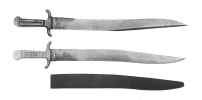
Photo from The American Bayonet
Updated 03/07/02
The John Ek Knife Company
In a recent conversation with a fellow collector he was describing an Ek
knife to me which he told me was mis-stamped with the wrong nomenclature. It
seems the knife was stamped with the No. 3 prefix to the serial number but
according to the collector it was a No. 6. He assured me it was a No. 6 and I
told him it was a No. 3 knife, that I was certain of. He hunted up his copy of
the Ek catalog and produced a picture and description of it. I agreed with him
that the knife in the picture and the catalog was a No. 6 but that did not
change the fact that his knife was a No. 3, it was marked correctly and again
I was sure of it. The fellow was becoming annoyed so I had to tell him the
truth, he was right if the knife had been made in WW II, but it wasnít, and
that dear reader is the key. Most folks are not aware that John Ek changed his
numbering system at some point after WW II. Several knives were discontinued
and several more were added. Due to the elimination of some of the WW II era
knives the remaining knives moved up a notch in the numbering system and the
newer models filled in the higher numbers. So a WW II era No. 6 knife became a
No. 3 post war knife due to the elimination of the WW II No.ís 3, 4 & 5.
Just for the record the No. 8 WW II era knife, the Paratrooper, was also
eliminated from the lineup. A short table follows to make all this a little
easier to visualize:
1 = 1
2 = 2
3 = Discontinued
4 = Discontinued
5 = Discontinued
6 = 3
7 = 4
8 = Discontinued
9 = 5
10 = 9
New = 4A
New = 6
New = 7
New = 8
New = 10
New = 11
New = 12
One of the most hard to believe facts concerning John Ek
knives is the fact that the government allowed him to use chrome moly steel
during World War Two. There were huge factories and million dollar
corporations that could not get that kind of approval to this finest of steel.
Ek not only secured the steel but met with government officials on using
disabled help and being under the suggested price ceiling. While we are
discussing Ek knives lets put to rest the numbering system also. I have never
seen the exact date pinned down but most agree it was in 1943 that John
started to serial number his knives. The numbering system worked on the power
of tens. The serial number was also designed to contain the model number. To
achieve this John selected and Alpha-Numeric system. The knives would be
numbered 1 through 999 then a letter would be inserted into the serial number.
This would continued through 999 again then the next letter in the alphabet
would be inserted. Hence serial number 2G546 means this is a Model 2 with a
serial number of G546 or the 6,546 Model 2 knife produced. A very simple yet
effective system of counting and still keeping production levels somewhat of a
mystery. During WW II John Ek Industries was based in Hamden Ct. at 1242
Whitney Ave as we pointed out in our Trivia Contest. In 1949 John relocated
the company to Miami Florida, a much friendlier climate to be sure. John Ek
passed away in 1976 ending that phase of the company, but the knives continued
to serve on with the military men around the globe. Although made in great
numbers Ek knives continue to be among the most sought after combat knives
pursued by collectors.
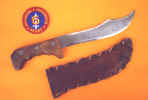
Quotes...
The supreme power in America cannot enforce unjust laws by the sword,
because the whole body of the people are armed, and constitute a force
superior to any band of regular troops ...
Noah Webster, An Examination of the Leading Principles of the Federal
Constitution,
Philadelphia (1787)
The V-42 Rides Again
In a recent exchange of e-mails with several VII Corps LRRP Co. (ABN)
members I learned of a continued service life of the V-42. As we all know the
V-42 is the knife made famous by the First Special Service Force, better known
as the "Devilís Brigade." The first commanding officer of
"The Force", Colonel Robert Frederick, was the driving force behind
the elite group and the selection of the V-42 as the sole knife of that
"special" group. No need to go on here about the famous exploits of
the FSSF but suffice it to say they made history. The group was officially
disbanded after fighting in Southern France on January 6, 1945. The remainder
of the FSSF men and the Ranger survivors became the 474th Infantry.
Upon the shutdown of the FSSF and the resulting transfer of men and equipment
much of the FSSF gear went into storage. According to Col Orval J. Baldwin,
World War II era FSSF Group S-4, as many as 350 V-42's were placed into
storage at the draw-down and transfer ceremonies. Where these knives went from
there is a mystery as they have not shown up in any photos or written text
until now... thatís right, they were found, in 1962! Letís not get ahead
of ourselves here, a little background is needed to fill out the story.
In the 1950's the world was a quickly changing place. The United States was
involved with Communist China in a little place called Korea. While that was
happening the face of Europe was also being influenced by the Communist
threat. Although a "hot" war was not being fought on the European
continent the "cold" war was freezing fast. The US and NATO feared
the possible outbreak of war with the Soviet Union and its Warsaw Pack allies.
In the event such a situation arose, the US would need a unit capable of
providing it with information on the situation deep in the enemy's area. This
information would be critical in any future conflict arising in Europe. Allied
Units stationed in Germany had units capable of providing them with this type
of information, the U.S. did not. With this in mind a new type of force was
needed, men to go behind undrawn battle lines to feed back intelligence to the
generals planning the fight. Much like the British Long Range Desert Group,
working behind lines but in a completely military organization. In 1958 the
first LRRP units were formed by 7th Army and assigned to V and VII Corps.
Unlike the OSS or the CIA, the group would be uniformed military men, not
spies. The name selected was "LRRP" or Long Range Reconnaissance
Patrol. Not really a new concept but a new name to go with a newly formed
group to the U.S. Army. Initial volunteers were selected from throughout 7th
Army, but were primarily drawn from airborne units of the 8th Infantry
Division. Each unit consisted of a small HQ, a communications platoon. and two
patrol platoons. The patrol platoons consisted of eight four man patrols. Both
units were capable of conducting airborne operations; surviving for long
periods of time, with little or no outside support; and were highly skilled in
long range communications skills. What was generally unknown at the time was
that unit members were also secretly trained in deploying Special Atomic
Demolition Munitions (SADMs). These highly trained men going into "harmís
way" were of the elite group and with the advanced training they received
they knew it. The distinctive head gear then worn by the LRRPís was the
Maroon Beret of the Airborne. At that time the elite only beret head gear was
earned not just issued as it is today. The men noticed the French Foreign
Legion wearing the distinctive Lizard pattern camouflage utility uniforms. Not
having the available funds to purchase uniforms the men resorted to the same
tactic used by Armies for centuries, barter. If they could come up with
something the French wanted, they could trade. But what did the US Army have
that the French wanted, they were already using just about every item in the
US inventory due to the Lend Lease arrangements and the Marshall Plan of
re-arming the French. The search began of warehouses throughout Germany. Many
of the crates and cases had not been touched since World War Two, just sitting
in a damp, dusty warehouse, storage until the next war. In the ensuing search
of every warehouse in Germany for trading material a case of knives was found
by "Pappy Thomas" and his "detail" on a scrounging trip.
The location was somewhere near Ludwigsburg, is all that can be remembered
today. It seems they had "volunteered" to help clean up the
warehouse in the hopes of finding some of the good sleeping bags which would
be fine trading material towards those French uniforms. When they came upon
the knives it was a big surprise to everyone concerned including the warehouse
manager. They agreed to "requisition" the knives as long as the
warehouse supply folks could also acquire a few. Enough were found to equip
the LRRPís Company, the Supply folks, a few German NCOís in the 25th
Airborne Brigade stationed nearby and even enough to trade a few to the French
as they had set out to do.
The men wore the knives in the process of training and doing their duties.
It seems that someone had gotten wind of the "fearsome" knives and a
general recall was announced to turn in the dangerous weapons, again a few
were turned it. A vast majority were sent home, stashed, traded and generally
made to vanish before any turn in occurred. One enterprising fellow stashed
his under his wall locker after a short timer was afraid to take it home. By
the time this wise young fellow was to leave all the searching was over and
merely sent it home in his duffel bag. Many of the knives were used as
throwing knives, again exactly like the young men had done in World War Two
when the knives were newly made, some things never change and Young American
Boys are one of them! Many of the men continued to shine the knives and keep
them through out there careers. Many were mounted on wood plaques to hang on
the wall of an office or placed under glass to set off the credenza. Two have
been nickel plated to show off in any setting which makes the eye appeal all
the better. The two nickel plated knives have never been sharpened, mint
condition prior to the plating, after two careerís in the field. The
scabbard with one is also mint.
As this story was related to me several of the LRRPís, who communicate
quite freely with each other after all these years, have memories of the
knives, the places and the names associated with the knives only appreciated
by those who know the type of men and the appreciation for a fine knife.
Fellows like, Theo Knaak, Joseph Chetwynd, Jim Handlin, Rowe Attaway, Tom Lake
and others who sent me memories of the knife and the times. Rowe had his with
him in Vietnam. Some of the locals wanted to copy it but Rowe wasnít about
to let it out of his hands! One fellow, Patty Smith, forwarded a photo of
himself in white snow gear with an M14 rifle in the prone position along the
Czech Border, ready to take on the whole of the Russian Army if need be, well
armed with a real rifle and a very high profile knife on his hip in a ready
position, just like the day it was made. Hanging low below the snow parka just
like Colonel Fredericks envisioned it in 1942. A fitting tribute to the old
war horse known as the V-42. Brought back to life by the VII Corps LRRP Co. (Abn)
in front line duty, facing yet another enemy head on.
Thanks fellows, itís folks like you who make me proud to be an American!
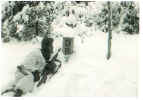
Photo of Patty Smith of VII Co. LRRPS on the Czech Border
looking into the town of Eisenstadt. Note the M-14 and the V-42 on the hip.
Last Months Trivia Question
During World War Two John Ek Mfg. Co. was located in Hamden Conn. What was
the street address they were located at?
Answer:
I checked several references to find 1242 Whitney Ave., Hamden, Ct. as the
correct address. In one ad displayed on Pg 197 in Cole II they have it listed
as 1212 Whitney Ave. That is the only reference to that address I could find.
The first correct answer with 1242 was our good friend Joe Palmieri. The 1212
address was pointed out to us by our good friend Gary Cunningham.
This Months Question
Who was the World War Two era owner of Robeson Shuredge? For extra credit
what did the fellows middle initial stand for?
As always, the first correct answer wins a large or xtra large WWW.USMILITARYKNIVES.COM
Pocket Tee Shirt.

They Patiently Wait
I walked into a little family grocery store yesterday and the television
was playing behind the counter. As I stood in line it was blaring out so I
looked to see what all the squawking was about, Oprah was on. Now I wonít
get into the merits of educational TV but this one needs to be discussed, just
on someone elseís dime, not mine. The show had relatives of the September 11th
attack on arguing about how much money they were getting from the government
or actually how much money they were being screwed out of! I donít think I
have ever wanted to be in a television audience so bad in my life. I just
wanted to ask one question on national television; How much money have the
survivors of the Bataan Death March received from any government? Maybe show a
few pictures of death, starvation and beheading and then leave. That quick
blip of the show I saw made me so mad I left that store without the items I
went in for and will no longer purchase anything there, my protest of Oprah
watchers!
Quote
Don't breed 'em if you can't feed 'em.
Larry Elder
Quote
I have always been of the mind that in a democracy manners are the only
effective weapons against the Bowie Knife.
James Russell Lowell
Mike Silveyís Newest Book.
Well our good friend Mike is at it again, a new book on U.S. Military
Knives is in the works. This one is along the lines of the previous books with
full color photographs and captions that educate us with facts on the knives.
Mike has chosen as his target for exposition this time the Military Folding
knife. I was lucky enough to view the pre-production layout of the book and
see the contents. I can assure you this will enlighten you to new facts
heretofore unknown on some of the knives pictured. Mike will also expose us to
several knives never before seen in any book or articles on the subjects. As
always the photographs are first class and the accouterments that accompany
the knives are first rate. Mike is an accomplished photographer using the
Medium Format film to superior effect for clarity and detail not available in
the more common 35mm format. Thatís right, professional results from
professional equipment, yes it costs more but is worth it in the long run. I
donít want to give too much away before the book hits the streets, which
should be in a few months, but the section on U.S. Navy Rope Knives is alone
worth the purchase price of the book. Mike is aiming to keep the cost down by
experimenting with the size of the book and perhaps the page count but you can
count on it being a first class project. I for one canít wait to see the
finished project. Full Speed Ahead Mike!!
Quote
The scariest thing about politics today is not any particular policy or
leaders, but the utter gullibility with which the public accepts notions for
which there is not a speck of evidence, such as the benefits of
"diversity," the dangers of "overpopulation," and
innumerable other fashionable dogmas.
Thomas Sowell 2002
This one hits close to home with me, every time I try to prove a
knife is not what others may think it is I get the shit knocked out of me. To
disagree with the established "facts" is akin to raping oneís
sister. The sentence is eternal damnation. Sometimes the folks can get pretty
rough!
USMC Bayonet 2000
Recently pointed out to us by our good friend Mitch Jenkins, the Eickhorn
company has posted on their web page the bayonet that was selected by the USMC
and then quickly reversed when they found out the rules of fair play were not
being followed. Below is a photo of the bayonet and the technical write up
that goes with it right from Eickhorn. For the other bayonets they make go to
for their page. For all you USMC fans out there note the handle... look
familiar?? Patterned after the good old 1219C2 Fighting / Utility knife.
Better known as the K-bar. Those Marines like their traditions!
General Information
Eickhorn-Solingen has especially designed the multi-purpose bayonet model
BAYONET 2000TM for the modern infantry soldier in the 21th century for multi
terrain operations (urban, peacekeeping, etc.)
Characteristics
This new generation BAYONET2000TM combines several functions into one
bayonet- knife-and-tool with a very flat, sturdy and compact design, good
balance, light weight and ready for the toughest field-work. The BAYONET2000TM
is compatible withe the U.S. Land Warrior system, fitting on the individual
soldier and accessible and operable with one hand. Provided the user follows
the instructions as to dry and non-oily conditions the BAYONET2000TM is
electrically insulated up to 1.000 Volts, temperature- resistant between
-40įF (-40įC) and +176įF (+80įC), fungus-resistant, NBC-resistant and
de-contaminable.
Quality assurance
We herewith certify that all our products are manufactured according to
MILSPECS and NATO -standards (Eickhorn-Solingen manufacturer Nato Code: C
2436) and tested following EN ISO 9001 and AQAP 110 standards.

Note the 1219C2 style handle on the proposed new bayonet,
Cool!
ENLIGHTENED PERSPECTIVE
If you will take the time to read these. I promise you'll come away with an
enlightened perspective. The subjects covered affect us all on a daily basis!
They're written by Andy Rooney, a man who has the gift of saying so much with
so few words.
Enjoy.......
I've learned.... That the best classroom in the world is at the feet of an
elderly person.
I've learned.... That when you're in love, it shows.
I've learned.... That just one person saying to me, "You've made my
day!" makes my day.
I've learned.... That having a child fall asleep in your arms is one of the
most peaceful feelings in the world.
I've learned.... That being kind is more important than being right.
I've learned.... That you should never say no to a gift from a child.
I've learned.... That I can always pray for someone when I don't have the
strength to help him in some other way.
I've learned.... That no matter how serious your life requires you to be,
everyone needs a friend to act goofy with.
I've learned.... That sometimes all a person needs is a hand to hold and a
heart to understand.
I've learned.... That simple walks with my father around the block on summer
nights when I was a child did wonders for me as an adult.
I've learned.... That life is like a roll of toilet paper. The closer it gets
to the end, the faster it goes.
I've learned.... That we should be glad God doesn't give us everything we ask
for.
I've learned.... That money doesn't buy class.
I've learned.... That it's those small daily happenings that make life so
spectacular.
I've learned... That under everyone's hard shell is someone who wants to be
appreciated and loved.
I've learned.... That the Lord didn't do it all in one day. What makes me
think I can?
I've learned.... That to ignore the facts does not change the facts.
I've learned.... That when you plan to get even with someone, you are only
letting that person continue to hurt you.
I've learned.... That love, not time, heals all wounds.
I've learned.... That the easiest way for me to grow as a person is to
surround myself with people smarter than I am.
I've learned.... That everyone you meet deserves to be greeted with a smile.
I've learned.... That there's nothing sweeter than sleeping with your babies
and feeling their breath on your cheeks.
I've learned.... That no one is perfect until you fall in love with them.
I've learned.... That life is tough, but I'm tougher.
I've learned.... That opportunities are never lost; someone will take the ones
you miss.
I've learned.... That when you harbor bitterness, happiness will dock
elsewhere.
I've learned.... That I wish I could have told my Dad that I love him one more
time before he passed away.
I've learned.... That one should keep his words both soft and tender, because
tomorrow he may have to eat them.
I've learned.... That a smile is an inexpensive way to improve your looks.
I've learned.... That I can't choose how I feel, but I can choose what I do
about it.
I've learned.... That when your newly born grandchild holds your little finger
in his little fist, that you're hooked for life.
I've learned.... That everyone wants to live on top of the mountain, but all
the happiness and growth occurs while you're climbing it.
I've learned ... That it is best to give advice in only two circumstances;
when it is requested and when it is a life threatening situation.
I've learned.... That the less time I have to work with, the more things I get
done.
Rumor Control
Before you forward that e-mail with the great story, you know the type that
is almost too good to be true, check it out. My favorite place is http://www.snopes.com/index.html
They can put an end to the most interesting topics in just a few
clicks. Check it out.
More on the Koran
After the quick blip I wrote about this last month I have been informed
that the reason the Koran is only in Arabic and not translated into English is
that it is the exact word of God and if it was translated it would no longer
be in his words. Finally I understand the reason behind the decision. Although
most Moslems do not speak that language they all pray in it, the above is the
reason. Searching it for cutlery related quotes is extremely tough.
Updated 4/1/02
The Screaming Eagles Bayonet
Lan-Cay has produced M9 bayonets with the 101st Airborne
Screaming Eagle stamped into the blades ricasso. At this writing I do not know
the exact amount produced but they were made and are currently in the hands of
some of the 101st men going into harms way. When I find out the
details we will have them written up right here for all to see. Can anybody
add to this discussion, let me know!
More on VII Corps LRRPS V-42's
The fellows forwarded me a few more photographs of the
V-42's they carried and used in the 1960's. Here they are for all to see. I am
currently working on an article for Knife World on these knives and warriors.
Stay Tuned!

This is Jim Handlin's V-42 he mounted and added a few
shoulder patches to. Super display Piece!

Theo Knaack brought home two V-42's from his tour with the
VII Corps LRRP's in the 1960's. Another super Group!
Thanks Guys, keep us in the loop with any more V-42's or any other knives
you dig up!!
Hawking Products
This past week I was manning a booth at a trade show for my real job. Set
up next to us was the Cutco Cutlery booth. Most of you reading this also know
of Cutco Cutlery. It is very good cutlery but so are a number of others. This
is not about the knives or scissors them selves as much as it is about the
sales techniques I observed. Most Cutco sales people are college age students.
They are given a sales class and a few ways to over come just about any answer
the people will throw out to them. I am telling you these kids were good.
Aggressive but not to the point of being rude to the people walking by. They
thought they knew everything there was to know about knives and they looked
and talked like they did. I just kept my mouth shut and watched, it was great.
On the last day there the factory man arrived to help with the last day and
the closing up of the booth. I struck up a conversation with him on his sales
force and told him what a good job they had done. We then spoke a little about
some knives. He tried to throw the sales pitch on me but I stopped him short.
Again we chatted a bit about the company history and the ownership of Ka-Bar.
He tried selling me again with the "440 Surgical Steel" story. I
asked him what grade, A B or C and he hesitated a bit. I asked him what
manufacturer made the famous "Surgical Grade Steel" and he stopped
again. When he regained his sales composure and tried again I finally broke
down and told him that I had first class kitchen cutlery before he was born, I
have collected knives my entire life have owned thousands and wrote a monthly
column for Knife World he kind of came to a halt. It was the only time all
week I noted that a sales person at that booth did not have an answer. They
really train those kids good let me tell you, I had a blast just watching all
week. If they would have just had a few bayonets there to sell that would have
been real interesting!!
Chocolate Mathematics
Get a calculator or paper and pencil when you have time. Don't scroll to the
bottom till you
do it all.
DON'T CHEAT BY SCROLLING DOWN FIRST! It takes less than a minute....... Work
this out as you read. Be sure you don't read the bottom until you've worked it
out! This is not one of those waste of time things, it's fun.
1. First of all, pick the number of times a week that you would like to have
chocolate. (try for more than once but less than 10)
2. Multiply this number by 2 (Just to be bold)
3. Add 5. (for Sunday)
4. Multiply it by 50, I'll wait while you get the
calculator................
5. If you have already had your birthday this year add 1752.... If you
haven't, add 1751 ..........
6. Now subtract the four digit year that you were born. you should have a
three digit number .....
The first digit of this was your original number (i.e., how many times you
want to have chocolate each week). The next two numbers are ........... YOUR
AGE!
M3 Trench Knife Discussion
While at the National Archives last week I looked up the basic notes on the
M3 Trench Knife, or I should say I tried to. It seems some collector beat us
to them. Many are listed in the file indexes but missing from the files. It
seems that quite some time ago a collector found them and removed them, they
are now lost to future generations. One that was missed by the previous thief
was an Ordnance Committee Technical Meeting memo listing the minutes. In this
page and a half sheet took place a fascinating discussion. We shall reproduce
it here.
Ordnance Technical Committee Meeting Minutes on Item # 19494
Mr. Gray: With the experience that has been gained in the field in various
theaters, there seems to be a necessity for reviving the trench knife. The
Ordnance Department had a considerable number left over from World War I, and
these have been and are being issed to troops. However, The supply was
inadequate to meet the requirements, and a replacement for the trench knife as
used in World War I was developed. This subcommittee report recommends the
adoption of the trench knife M3 with Scabbard, M6; and that the Trench Knife,
M1918 Mk I be removed from the Table of Basic Allowances.
Colonel Borden: Are there any comments? This is a rather important item,
although it is an individual piece of equipment. Has the Marine Corps looked
the knife over?
Colonel Hussa: Yes, Sir. They Have. However, the Marine Corps have already
adopted a type of trench knife. We gave it a very careful study. It doesnít
conform exactly to the design that is recommended here. We found that the
production of the Marine Corps type in the quantity we want, which will be
something in the neighborhood of 90,000 per month, would be delayed by the
reason of the stock required to be used in the blade. The type of steel, not
the type, but the basic stock dimensions in the Marine Corps type of knife is
not standard. What we have here is something we can obtain in the mills right
now.
Colonel Borden: The Infantry has looked this knife over and it is
satisfactory?
Colonel Oseth: Yes, Sir. I might say for the benefit of all, whenever we
find any two anywhere that agree on the exact characteristics of such a knife,
we tried the Ordnance, and the Infantry tried all the different ideas of
getting an all purpose knife. They were all unsuccessful. This knife is an
attempt to embody all the best characteristics of all of them. It is quite
close to what is known as the commando knife. It is a sample of a straight
fighting knife with a possibility of some slight general utility use, but it
is not an extension to, a can-opener, or a bayonet. It is a straight blade
knife with a sturdier point then the commando knife, a larger and firmer grip.
Colonel Borden: I imagine that this meets the requirements that were
indicated in the report from Guadalcanal?
Mr. Gray: Well it is pretty hard to come down to cases of essential
figures. This investigation has included conferences with the British who had
experience in the commando type of fighting, and it is pretty hard. I can
assure you it is pretty hard.
Colonel Borden: It is a 12" knife, and it is already in the report?
Mr. Gray: It is a 12" Overall knife
Colonel Borden: That is what I interpreted they wanted.
Mr. Gray: As a matter of fact I was very much amused. Everyone said, well
you can make a knife, and after the men get it you can gamble, it isnít
going to be what it was. They are going to modify it when they get it.
Colonel Borden: Gentlemen, I extend this, because of the fact that there is
considerable interest in this item, not only among this group, but throughout
the War Department. It appears to be a very satisfactory solution. I am glad
to hear it is quite satisfactory to the Infantry. Perhaps the Marine Corps
will look upon it with favor when there supply is exhausted.
Colonel Hussa: It is very little difference between the knives.
Colonel Borden: Any other comments? If not this item is approved. Next
item.
So we can see from the minutes from this meeting that the M3 was adopted,
with M6. The M1918 Mk 1 was removed from the basic allowances. The M3 was a
design compromised due to steel availability and it was copied from the F/S
but is a sturdier design. It was not to be a bayonet or a can-opener. Col.
Hussa was a representative on the Board from the Marine Corps and knew the
1219C2 Fighting / Utility knife well. The part I like the best was when the
fellow assured the rest of the fellows that the troops will modify it
regardless of what type of knife they selected! Theatre Altered knives here we
come.
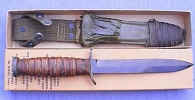
In the box, what a find!
Scabbard M8
While on the subject I also found the notes from the Ordnance Technical
Committee meeting on the T2 scabbard recommendation to become standardized as
the M8 scabbard. Item number 20467 dated April 24, 1943 recommends such action
but one area I found interesting, list it hear for your reading pleasure.
b.) The proposed scabbard is constructed of laminated fiber filled thermo
plastic similar to that used in the bayonet scabbard, M3. This scabbard is a
friction type and is provided with a fabric web loop which allows the
scabbard to be carried on any type of belt and it is considered anti
rattle. The small hole in the tip of the scabbard and a thong provided make it
possible for this scabbard to be held tightly to the body or to the leg.
The italics and underlined section is mine and not in the original but it
is to point something out. Well it seems that somebody was fibbing or
uninformed as the web loop did NOT fit any type of belt or in fact most worn
by combat personal. This very well be the reason for the M8A1. A simple
mistake like this created a recall of existing scabbards to be converted and a
new specification to be drawn up to make the longer frog and M1910 belt hangar
added. I have observed many modification of the M8 scabbards over the years, a
few are listed here:
M8 with hooks sewn in (both colors, khaki and green)
M8 with oval ring added and a short piece of webbing added to attach a hook
, an extension of sorts.
M8 metal throat and body with longer frogs ala M8A1
M8 metal throat with M8A1 body and short frog
M8 metal throat with M8A1 body with metal tip and short frog
It seems with the urgency needed and the extremely easy repairs to be made
the M8 / M8A1 scabbards can be found field modified in any sort of
configuration. That's just a few examples so it seems that many were
"rebuilt" or "altered" to fit the urgency they were then
in. Just my observations. It also seems that knives were not the only thing
modified by the soldier living in the field."
Quote
One of the sad signs of our times is that we have demonized those who
produce, subsidized those who refuse to produce, and canonized those who
complain.
Thomas Sowell 2002
The Red Spacer Ka-Bar Revisited.
In an article I wrote several years back for Knife World I listed the red
spacer knives as made by the Union Cutlery Co. In that article I also listed
what I had thought, at the time, to be a freak or anomaly version. As the one
I had and used for the photos, was, up to that time, the only one I had ever
spotted I concluded that point. Well it is time to eat crow and make a
retraction. Other collectors have contacted me with the double thin red spacer
knives. Not many but enough to know that mine was not a "one of a
kind" knife. Since then I have recently seen two on ebay in a two week
time span. While these knives can in no way be considered common seeing two in
that short time span leads me to believe that it is more then just a few. To
date I can count about half a dozen known examples. Our good friend John
Fischer contacted me that he had two prime examples in his collection. These
red spacer knives are notoriously hard to find in any condition and can be a
real bear to find in excellent shape. Early knives were issued to landing
troops who took enormous casualties and used their knives on a daily basis.
The survivors of those knives are true war trophies having been there, done
that. While not knowing the exact path to follow as all the records are long
gone I would place the double thin red spacer in the number three position of
production. First generation would be the thick red with the red, black, red
spacers at the pommel, Second generation would be the thick red with the
triple black spacers at the pommel and then in third would be the double thin
red with the triple black at the pommel. This may be due to the fact that
Union ran out of thick red spacers or were in the process of ordering more or
a worker who just used the thin red as he didnít want to walk over and get
the thick ones, perhaps that small point we will never know. It could be that
the fellow doing the hafting just liked the look of them better. We do know it
was never a specification change officially so for what ever reason it was
only known to Union Cutlery. As for numbers made... your guess is as good as
mine, remember that the entire red spacer production run of all three
generations didnít last more the 60 to 75 days, lets just say few and leave
it at that.
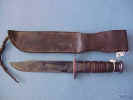
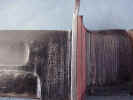
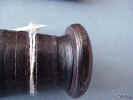
As you can see from the above photos the double red spacer
knives are in the "triple black" pommel spacer family. This is the
actual knife I just purchased on an ebay auction. Nice photos Chris!
Quote
To fight with a sword may be brutal, but honorable. To fight with a germ is
merely disgusting.
Jeff Cooperís Commentaries Vol 10 No. 3
Crozier Technical High School
Who can help me with this one? Anyone live in the Dallas Texas area? It
seems that the Crozier Technical High School in Dallas Texas wanted to help
out in the war effort. As it was a vocational type school and metal working
was on the curriculum it made sense to use that talent in the best way
possible. In response to the call for knives for departing servicemen the
school under took the mission to supply them, by the middle of 1944 they had
supplied over one thousand knives for the war effort. Now for the tricky part,
what did they look like? Has anybody seen one? Can you share it with us? As
the school has since been closed they can not be contacted directly for
information. I called the Dallas Public Library and spoke with the Texas
History Department. After a short conversation and a few ideas I wrote out a
letter and forwarded it to Amy who promised to run it down with the
information available to her in that department. Letís hope she can find it.
Perhaps a few year books with the graduating class of 1943, 44 or 45 would
show us an example? With over one thousand made by school boys this would be
an awesome item to find and to make a high profile example out of. Perhaps
those turned wooden handled sword blade knives were made by the school or the
cast aluminum handles? Perhaps they made knives with black hose handles and
knuckle guards, that would be a pisser wouldnít it?? Knuckle knives made in
a high school and attributed to the OSS! In todayís school a student would
be suspended for carrying a set of nail clippers and in 1944 they were
producing fighting knives in bulk. Says a little bit about society doesnít
it? This is one we need to run down.
Last Months Trivia Question ....
Who was the World War Two era owner of Robeson Shuredge? For extra credit
what did the fellows middle initial stand for?
The wartime owner was Saul S. Frankel. His middle initial "S"
actually stood for nothing at all as he did not have a middle name. He added
it as it looked better that way.
No one answered correctly so I will keep the T-shirt to wear it myself.
This months question...
On the M6 leather scabbard for the M3 Trench Knife one version is marked
L&C, what does the L&C stand for??
E-mail me the answer and win a US Military Knives .Com Tee shirt like this
one Tee_Shirts
Cutting Down Bayonets and Scabbards
During World War Two we had the M3 plastic scabbard and the cut-down M3A1
to fit the M1905E1 and the M1 bayonets. Why then did the Ordnance Department
change the name to M7 when they made the new scabbards in the M1 length? The
question bothered me for a few years but I could never find the answer.
Actually the change from M3 to M3A1 should never have occurred as did the
M1905 to M1905E1 nomenclature which stuck. When the M1905 was cut down it
officially became the M1. It was not an improvement on the M1905 basic design
it was different altogether. They could interchange but that alone is not
enough to justify it as an A1 nomenclature. The same is true of the M3 to the
M3A1 switch. It was a change but not a product improvement based on the
current design, it was a specification change which deviated from the original
beyond the point of product improvement. Trouble started almost immediately
when the M3A1 was announced. Supply folks needing scabbards for the M1905
bayonets ordered what they thought to be the newest product improved items.
Much to their surprise they werenít of much use when they arrived, being 6
inches too short! Perhaps we are getting a bit ahead of ourselves here, lets
go back to the beginning.
It actually all began on August 22, 1942 when the Cavalry requested their
bayonets be shortened. It had nothing to do with saving steel or shortages or
better balance or any of the other hundred reasons given as fact, it was
because the long bayonets kept poking the horses when the riders mounted the
horse or got hung up when trying to enter a tank. The Cavalry requested a
shorter bayonet to alleviate those problems. It was only for the Cav not the
rest of the Army as that would have posed too large a problem to deal with in
war time. It was just a request. The Cavalry Board tested the short bayonet
over a two month period and recommended they be issued to all Cavalry officers
and men whether armed with the M1, M1903 and those not armed with the rifle at
all. It seems they even liked it as a hand weapon for self defense.
Not to be outdone the Infantry Board also tested the short bayonet and
recommended that all M1905 bayonets be cut down to 10 inches for the entire
Army and that the M1917 bayonets also be shortened! To top it off they
recommended that a hand guard be installed to make a knuckle of sorts for
fighting. In a report issued February 10, 1943 when Ordnance ordered the
change from Bayonet, M1905E1 & Scabbard M3 to Bayonet, M1 and Scabbard,
M3A1 for the set they also recommended another study for the adoption of the
hand-guard. Their recommendations were as follows:
a.) That the Bayonet, M1905E1 be approved as: Required type, Adopted type,
Standard item and be assigned the nomenclature Bayonet, M1.
b.) That the Bayonet M1905 be reclassified as Limited Standard.
c.) That the Scabbard, Bayonet, M3, now designed to accommodate the M1905
bayonet be modified by shortening to sheath the Bayonet, M1 and that is be
assigned the Nomenclature Scabbard, Bayonet, M3A1
d.) That the Bayonet, M1 with Scabbard, M3A1 be put into production as
rapidly as possible, consistent with no reduction in scheduled deliveries now
required.
e.) It is further recommended that a study be initiated to design a
detachable hand guard for the bayonet, in accordance with the recommendation
of the Infantry Board.
So we can see that the M1905 became the M1905E1 and then progressed on to
become the M1 bayonet. The M3 scabbard went directly to the M3A1 scabbard. I
donít know what happened to the order for cutting down M1917 bayonets but I
have never seen it stated or listed anywhere other then in this report. As the
Cavalry Board and the Infantry board tests were forwarded to the Ordnance
Board for approval perhaps Ordnance put the hold on the M1917 cut down
procedure and stuck with the M1905 shortening program only. In either case it
was April 6, 1943 when the next report appeared to correct the earlier
mistake.
A memo from the Ordnance Committee on the sunject of scabbards is brought
to our attention.
Subject: Scabbard, Bayonet, M3A1 - Change in Nomenclature to Scabbard,
Bayonet, M7.
In short it recommends that: The designation M3A1 was furnished since it
was intended that the scabbard be a shortened M3 scabbard; however, this
designation implies that the M3A1 modified scabbard could be used with the
M1905 bayonet. This is not possible. This change in designation will associate
the M3 scabbard with the M1905 bayonets and the M7 scabbard with the M1
bayonet.
So we have the M3 scabbard officially recommended changed to the M3A1 on
2/10/43 and officially changed on 3/1/43. The official change from M3A1 to M7
was recommended on 4/6/43 and presumably adopted in May of that year, I didnít
find the actual paper. So the official scabbard lineage for the M1 bayonet was
the M3A1 and then the M7 regardless of whether they were cut down or newly
made. Just wanted to state that for the record.
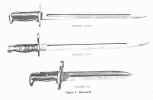
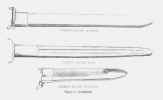
Hospital Corps Knives
One of the most often asked questions is "What did the Hospital Corps
do with the large boloís?" And the most often given answer is
amputation and / or circumcision. I guess it just sounds good for I too have
given that answer often just to evoke a response. Another answer is to make
stretchers with. This is a good answer as it was one of the uses but not the
specific one in mind. First a little exploration of casualties is in order to
see why they needed knives in the first place. OK, we could understand
scalpels but bolos, what would a medic need one for? The answer is that it
wasnít for the medic at all but still a Hospital Corps man.
It is stated that during World War Two over 17 million patients were
treated by the armed services. Of these the Army treated 640,000 combat
casualties, so who were all the others and why were they treated? Well who
ever they were they were 20 times more likely to visit the doctor they
somebody wounded in battle. V.D. was a big problem, so large in fact they made
training films and booklets about it. But we all know they wouldnít need a
knife that large to cure that problem, more like that scalpel would do the
trick, ouch! The real need was created by a disease but not one caught so
pleasurably, these killers would come from the environment created by nature
and aided by man.
On Guadalcanal it was estimated that over 70% of the combat forces had
Malaria. It put 648 of every 1,000 men out of commission in the China, Burma,
India theatre. On Okinawa there were 300,000 men in a 600 yard front line, it
is said you tell where the front was with your eyes closed just by the smell.
You see there werenít any "johnny on the spots" to run to, you
went where you could and hoped you didnít get shot. Combine that with Lice,
Fleas, Flys and Rats and you can see where this is heading. The boloís were
made to clean up the environment to help stop the proliferation of disease.
They could help in the cleaning of downed trees causing water to puddle, drain
swamps created by massive shelling and build hospitals and shelters for the
sick. It was created as a general purpose tool and that it was. The rounded
tip of the Model of 1905 was to express that the bearer was not a combatant
but a relief worker. The same applied to the USMC machete made much later.
This was supposedly to coincide with a treaty or convention that preceded the
large one in Geneva but I have not found the name of it. Pity the Japanese
didnít really care as a prisoner to them was worse then a dead person so
even the highest ranking officer or Doctor was presumed dead and made to work
as a slave.
So there we have it, the short answer on why the HC knives were made.
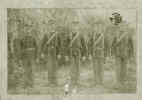
Here is a dandy photo of the M1905 Hospital Corps Knife from
our good friend Carter Rila's archives
HEAVY LIFTING
A priest walked into a neighborhood pub. The place was hopping with music and
dancing but every once in a while the lights would turn off. Each time after
the lights would go out the place would erupt into cheers.
However, when the revelers saw the town priest, the room went dead silent.
He walked up to the bartender, and asked, "May I please use the
restroom?"
The bartender replied, "I really don't think you should."
"Why not?" the priest asked.
"Well, there is a statue of a naked woman in there, and her most private
part is covered only by a fig leaf."
"Nonsense," said the priest, "I'll just look the other
way."
So the bartender showed the clergyman the door at the top of the stairs, and
he proceeded to the restroom.
After a few minutes, he came back out, and the whole place was hopping with
music and dancing again. However, they did stop just long enough to give the
priest a loud round of applause.
He went to the bartender and said, "Sir, I don't understand. Why did they
applaud for me just because I went to the restroom?"
"Well, now they know you're one of us," said the bartender.
"Would you like a drink?"
"But, I still don't understand," said the puzzled priest.
"You see," laughed the bartender, "every time the fig leaf is
lifted on the statue, the lights go out in the whole place.
Now, how about that drink?"
Sent to me by Sam Rodriguez, a VII Corps LRRP and V-42 admirer.
Collins No 18 Machete
I just watched an Ebay auction end with the prize going for $666.59 and I
thought that was a great deal. Now you may ask what kind of Collins No 18
machete is worth that much?? One of the many things to watch for, as we all
know, is the markings. What becomes tough is that Ebay lists thousands of
knives, bayonets and machetes every day. What made this one different you
ask... It was a "Sword Stamped" model not the typical Legitimus, Arm
and Hammer marked model. Perhaps I have seen 6 of them in excellent plus
condition sold in the last 20 years, if that many even. They all had Green
Horn handles as they were made prior to the molded Bakelite handles. Although
they all may be made from the same substance many look quite a bit better then
others. Look for streaks of white in the horn to add flair and color. All had
the red brass guards and pins, again common as this was the only offering in
1934. So there are not many variations to this model except for the markings,
and it is still a tough one to find. It may not have been a steal but I
thought it a great price. Lucky is the collector who can find one of each
model and marking in nice condition. Just goes to show you that the nice ones
are still out there. Item number was 1082988455 if you want to take a peak.
Three highly important documents in our
lives...
1. The Ten Commandments - 75 words
2. The Declaration of Independence - 176 words
3. The Constitution of the United States - 275 words
Then we have our current group of officials...
1. The restrictions on the sale of cabbage to Russia - 259,000 pages!!
2. In 1913 the first income tax form was 3 pages, today there are 650 forms
with instruction booklets for each one. I havenít found an estimate on word
or page count. Several million would be conservative.





